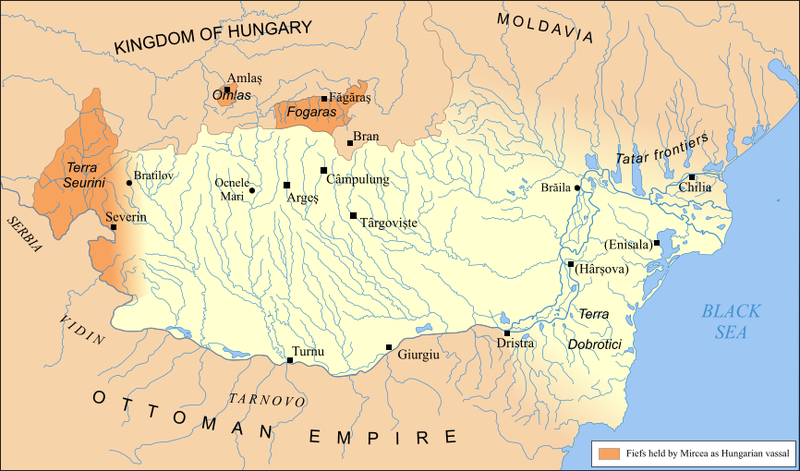A short history of Wallachia
The history of the country laying south to Carpathians, up to the Danube and to the Danube Delta, in East, starts by the end of the 13th century. The Black Prince (of cuman or slave origin) run away from its feudal duchy, Fagaras and shelters South to Carpathians. That happens because the duchy was given to Ugrinus, a Hungarian noble, by the king of Hungary Andrew III.
A unification process of the small principalities started and in the XIVth century, Basarab I "the founder" ("Intemeietorul" - in Romanian) was already ruling an area more or less equal to Wallachia as it survived for five centuries. Except Oltenia, that still conserved a certain autonomy. The new country was having an average size (cca 77000 sq. km) but a very important strategic position.
The Hungarians kings tried, since the very beginning, to include the new country in the empire, but it managed to preserve the independence (although they were under the strong influence of the big empire). In 1330, when Basarab occupied the stronghold of Severin, on the Danube, the Hungarian king Charles Robert of Anjou ask him the fortress. As Basarab refuses to give it, Charles Robert starts a military campaign and threatens the Wallachian prince. But Basarab manage to negotiate a peace pact: he promised paying an amount equivalent of 72 kg of gold (or 21000 golden forints). The Hungarian King turns back, but set fire on Basarab's residence in Curtea de Arges.
However Basarab surprisingly attacks Hungarian army in a place called Posada (not exactly identified until now). After the battle of 9- 11 November 1330 Charles I of Ajou difficulty manages to escapae, changing his clothes with that of a soldier. So Basarab conserves Oltenia and it was given under to be controlled by his son, his associate on the throne. Basarab dies in 1352 leaving on throne his son, Nicolas Alexander. This disturbs the Hungarian king, as he pretended that the Wallachian prince to be named by him. In 1359, Alexander (angry because the Hungarian king intercepts his correspondence with the pope) asked the patriarch of Constantinople his consecration under the name of “lord autocrator” and to give autonomy to the Wallachian church. So the church becomes
metropolis, taking like this a clear distance from the Catholic Church. Basarab I and his son Nicolas Alexander are buried in Câmpulung Muscel, in the Princely Complex.
Here is a map of Wallachia in the 14-th century (credits to Wikipedia):
 Mircea the Elder
Mircea the Elder (1386 - 1418) or Mircea the Old, grandfather of Vlad III Dracula was the most important ruler of Wallachia in 15th century, although his country was under a permanent threat by the part of Turks, who extended them power in Europe starting with the middle of the XIV-th century. in 1396, in Nicopolis, he sustains the West European armies of French and Borgognian knights, int the fight against the Turks. However, the allies failed (the heavy french cavalry had no chance against the easy turkish one).
In 1402
Timur Lenk, the Mongol khan, beats Bayazid in what we know now as
The Battle of Ankara and Mircea takes advantage of this in order to consolidate the independence of Wallachia. After 32 years of reign Mircea dies in 1418, leaving a powerful country.
After Mircea the Old ...










